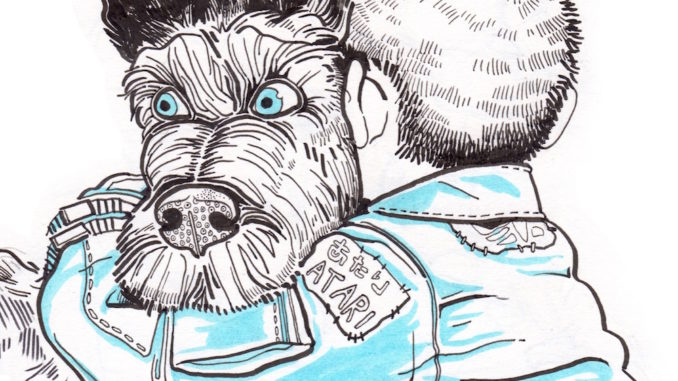
By Ray Freedman
“Isle of Dogs” is Wes Anderson’s Samurai film. The new movie from the iconic auteur is crafted with a deep love of Japanese cinema, homaging Akira Kurosawa and Hayao Miyazaki. Despite steeping itself in homage, the film holds its own and is remarkably unique — just like any other Wes Anderson movie.
The filmmaker has been charming audiences for over 20 years now with his meticulous eye and oddly comforting familial stories, and “Isle of Dogs” makes a good case for animation as the filmmaker’s best format. The absolute control gives the filmmaker a toolbox that best suits his mastery. Although I do love his live-action films, they do not achieve the same level of specificity and precision as his animated works. The sharpness of the altered reality Anderson and the animators create is unprecedented.
Twenty years in the future, a corrupt mayor has exiled all dogs to Trash Island due to a dog illness that has spread through Japan. The dogs wander around this island with nothing to do, the whole species of dog transitioned from domesticated to stray. They are Anderson’s figure for Ronin (masterless Samurai), a common class of hero in Samurai films. Ronin find themselves roving without a purpose, before stumbling upon a cause to commit themselves to. Early on in the film, there is a beautiful aside from one of the characters where he looks into the camera and says: “I want my master.” It becomes clear that the film is interested in this idea of service as life, a parallel between Samurai and domesticated dogs, both of which are known for their loyalty. The emptiness of Trash Island opens the film, which ultimately dedicates its story to characters finding purpose in service.
The plot is driven by Atari, the young nephew of the Mayor who flies himself to Trash Island in search of his dog, Spots. Spots was military-trained to be Atari’s guard dog before exile, and he has gone missing on the island. Atari enlists the help of five dogs who find his crashed plane. Led by Chief (voiced by Bryan Cranston), the group goes on the mission. Chief, in classic Samurai film fashion, is the outcast stray that becomes the hero of the film, and Cranston’s voice embodies a rugged loneliness that is perfect for the character. Like “Fantastic Mr. Fox,” the voice acting overall is incredibly earnest and human. All the voices portray a warm, vulnerable quality by having a relaxed and transparent tone. Interestingly, the animators developed the bodies of each dog after the actors were recorded, wonderfully merging sound to sight. The bodies of the characters feel real, as if the characters exist outside of the film.
The coordination of the motion and composition of the stills is remarkably dynamic. Kurosawa was the master of composing movement within a scene, and his influence shows here. The density of the frames demands the attention one would give to a novel. Anderson fills the shots to their very brim, and makes sure he is not wasting any space. The backgrounds are as busy as the foreground and the details are endless. Just as he fills up the visual frame, Anderson also layers the sound design of the film as much as possible without sacrificing coherence for the audience. Characters are constantly talking over each other to humorous effect, and every moving aspect of the film is given attention in the sound mix.
Anderson does not shy away from just how solemn and weary the story is. The characters are poor and hungry creatures who’ve been rejected by society, oppressed by the political rule. The dogs on the island slowly die off, and it is mentioned that one even commits suicide — another parallel to samurai, who would often submit to hara-kiri upon losing their master in disgrace. The darkness of the story is beautifully complemented by the stop-motion. Stop-motion must be perfect for it to succeed, as it demands the lighting and motion to be completely controlled, but this means that the moments of silence and stillness are literally, completely unmoving. Anderson allows the stop-motion to be imperfect by allowing the motion to stay still, breaking the illusion of it. Each still is as dynamic as a whole scene. The influence of Miyazaki comes through in these moments of silence, which allows the films depth to sink in.
Because of this depth, the film’s simpler sequences can feel tonally one-note. The second act of the film drags its feet in the “men-on-a-mission” trope just a tad too long. The character’s interaction drifts into classic Wes Anderson wit at the sacrifice of the film’s understated insight. This only lasts for a few scenes, though, and once the films poignancy is achieved you crave it throughout.
One leaves the film totally satisfied with the range of intellect and emotion the film contains. There is a haiku said in the film that is the perfect microcosm of this. “Whatever happened / To man’s best friend? / Falling spring-blossom?” The haiku is wholesome and warm, but empty and fleeting. It highlights Anderson’s maturation as a storyteller that beautifully counterpoints his childish sensibilities.
Subscribe to the Mossy Log Newsletter
Stay up to date with the goings-on at Lewis & Clark! Get the top stories or your favorite section delivered to your inbox whenever we release a new issue.

Leave a Reply